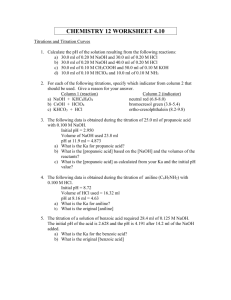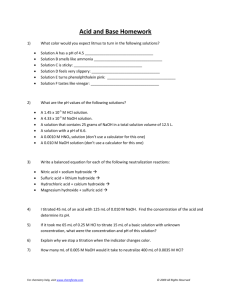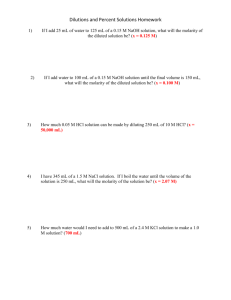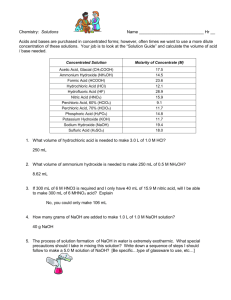notes ch4 Stoichiometry
advertisement
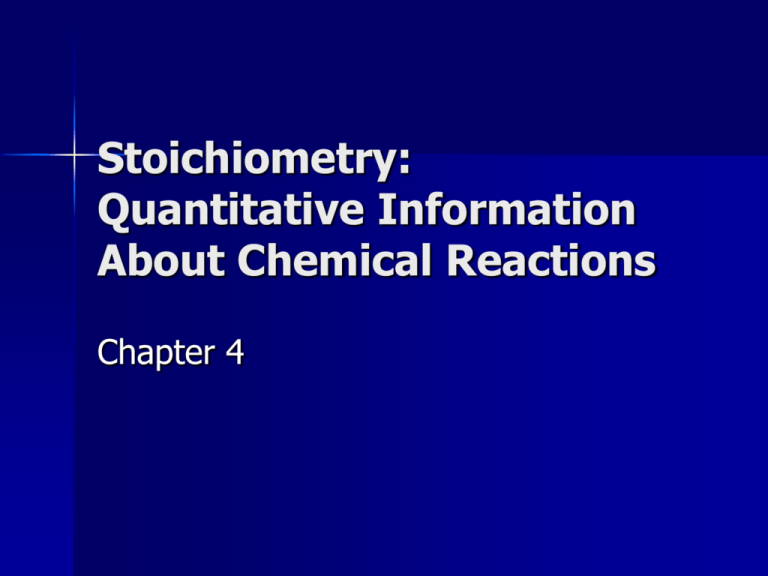
Stoichiometry: Quantitative Information About Chemical Reactions Chapter 4 4.1 Mass Relationships stoichiometric factor: a mole ratio based on the coefficients of reactants or products in the balanced equation What mass of oxygen, O2, is required to completely combust 454 g of propane, C3H8? What masses of CO2 and H2O are produced? C3H8 + 5O2 3CO2 + 4H2O 4.2 Limiting Reactants A limiting reactant is determines the amount of product formed. Step 1: Find the amount of each reactant. Step 2: What is the limiting reactant? Step 3: Calculate the mass of product. Step 4: Calculate the mass of excess reactant. Limited Reactants Pure silicon, required for computer chips and solar cells, is made by the reaction SiCl4 + 2Mg Si + 2MgCl2 If you begin with 225 g each of SiCl4 and Mg, which is the limiting reactant in this reaction? What quantity of Si, in grams, can be produced? 4.3 Percent Yield % yield = actual yield x 100 theoretical yield Methanol, CH3OH, can be burned in oxygen to provide energy, or it can be decomposed to form hydrogen gas, which can then be used as a fuel. CH3OH 2H2 + CO If 125 g of methanol is decomposed, what is the theoretical yield of hydrogen? If only 13.6 g of hydrogen is obtained, what is the percent yield of the gas? 4.4 Quantitative Analysis A substance of unknown concentration may be allowed to react with a known quantity of something else OR An unknown substance can be converted to one or more substances of known composition (back track) Chemical Analysis One method for determining the purity of a sample of titanium (IV) oxide, TiO2, an important industrial chemical, is to combine the sample with bromine trifluoride. 3TiO2 + 4BrF3 3TiF4 + 2Br2 + 3O2 Oxygen gas is evolved quantitatively. The gas can be captured readily, and its mass can be determined. Suppose 2.367 g of a TiO2containing sample evolves 0.143 g of O2. What is the mass percent of TiO2 in the sample? Determining an Unknown Formula The unknown pure compound is decomposed into known products. The reaction products are isolated in pure form and the amount of each is determined. The amount of each product is related to the amount of each element in the original compound to give the empirical formula. Determining an Empirical Formula A 0.523 g sample of the unknown compound CxHy is burned in air to give 1.612 g of CO2 and 0.7425 g of H2O. A separate experiment gave a molar mass for CxHy of 114 g/mol. Determine the empirical and molecular formulas for the hydrocarbon. 4.5 Concentrations of Compounds in Solution 1 mole element = 6.02 x 1023 atoms 1 mole molecular compound = 6.02 x 1023 molecules 1 mole ionic compound = 6.02 x 1023 formula units Molarity Molarity = moles of solute per liter of solution Example: Prepare 2.00L of 0.250M NaOH from solid NaOH. – Place 20.0g NaOH in a 2L volumetric flask; add water to dissolve the NaOH, and fill to the mark with water, mixing several times along the way. Molarity Sodium bicarbonate, NaHCO3, is used in baking powder formulations and in the manufacture of plastics and ceramics, among other things. If 26.3 g of the compound is dissolved in enough water to make exactly 200mL of solution, what is the molar concentration of NaHCO3? What are the concentrations of the ions? Preparations of Known Solutions An experiment in your laboratory requires 250.mL of a 0.0200M solution of AgNO3. You are given solid AgNO3, distilled water, and a 250.mL volumetric flask. Describe how to make up the required solution Dilutions M1V1 = M2V2 Prepare 2.00L of 0.250M NaOH from 1.00M NaOH. Add 500.mL of 1.00M NaOH stock solution to a 2L volumetric flask; add water, mixing until the flask is filled to the mark on the neck of the flask. Preparing a Solution by Dilution In one of your laboratory experiments, you are given a solution of CuSO4 that has a concentration of 0.15M. If you mix 6.0mL of this solution with enough water to have a total volume of 10.0mL, what is the concentration of CuSO4 in this new solution? Preparing a Solution by Dilution An experiment calls for you to use 250. mL of 1.00M NaOH, but you are given a large bottle of 2.00M NaOH. Describe how to make the 1.00M NaOH in the desired volume. 4.6 pH, a Concentration Scale for Acids and Bases pH can be calculated directly from hydrogen ion concentration pH = -log[H+] Can use the antilog of pH to figure out hydrogen ion concentration [H+] = 10-pH pH What is the pH of a solution of HCl, where [HCl] = 2.6 x 10-2 M? What is the hydrogen ion concentration in saturated calcium hydroxide with a pH of 12.45? 4.7 Stoichiometry of Reactions in Solution If you combine 75.0 mL of 0.350M HCl and an excess of Na2CO3, what mass of CO2 (in grams) should be produced? Titrations A titration can be used to determine the concentration of an unknown solution. A substance, present in unknown quantity, can be allowed to react with a known quantity of another substance. If the stoichiometric ratio for their reaction is known, the unknown quantity can be determined. Titrations Acid-base indicators are used to tell when the reaction is complete. When the solution changes color, the equivalence point (also called end point) has been reached. The amount of OH- equals the amount of H+. Amount of base (mol) = conc. of base (M) x volume of base (L) Acid-Base Titration A 25.0 mL sample of vinegar requires 28.33 mL of a 0.953 M solution of NaOH for titration to the equivalence point. What mass (in grams) of acetic acid is in the vinegar sample, and what is the concentration of acetic acid in the vinegar? CH3CO2H + NaOH NaCH3CO2 + H2O Titrations Often the concentration of the base is unknown and must be determined through standardization. – primary standard: a sample of solid acid or base is titrated with a solution of the base or acid to be standardized – titrate with another solution that is already standardized Standardization Hydrochloric acid can be purchased from chemical supply houses with a concentration of 0.100M, and such a solution can be used to standardize the solution of a base. If titrating 25.00 mL of a sodium hydroxide solution to the equivalence point requires 29.67mL of 0.100M mL, what is the concentration of the base? Redox Titrations A sample containing vitamin C is titrated with Br2, an oxidizing agent. C6H8O6 + Br2 2HBr + C6H6O6 A 1.00g “chewable” vitamin C tablet requires 27.85mL of 0.102M Br2 for titration to the equivalence point. What is the mass of vitamin C in the tablet? 4.8 Spectrophotometry It is possible to measure the extent of light absorption through a solution that is colored, and then you can relate this to the concentration of the dissolved solute. This method of quantitatively measuring light absorption is called spectrophotometry. Transmittance and Absorbance Transmittance is the ratio of the amount of light transmitted by or passing through the sample relative to the amount of light that initially fell on the sample (the incident light). Absorbance is defined as the negative log of the transmittance. As absorbance increases, transmittance decreases. Absorbance increases as concentration increases. The Beer-Lambert law Absorbance increases as path length increases. The amount of light absorbed by a solution can be used to determine the concentration of the absorbing molecule in that solution. A=εxlxc where ε is the molar absorptivity Homework for Chapter 4 After reading chapter 4, you should be able to do the following… P. 201 (77-86)



